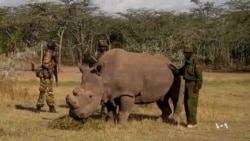The African rhinoceros is an endangered species. One kind, the northern white rhino, is very close to extinction. After the recent death of a female, only four northern white rhinos are still alive. Now scientists are trying to find a way to save them and increase their numbers.
The biggest threat to rhinos are poachers who kill them for their horns. Some people in Vietnam and China believe that pills made of ground rhino horn can cure diseases and disorders although no scientific evidence proves this.
Since 2008, poachers in South Africa have killed almost 3,000 rhinos. The International Union for Conservation of Nature warns that they may become extinct before 2026.
The northern white rhinoceros, which is actually grey, is extinct in the wild. The four remaining rhinos left are held in captivity; three females and one male, called Sudan.
Zachariah Mutahi takes care of the male rhino.
"If we lose him, it will be a very big loss for the endangered species."
The Ol Pejeta Conservancy is a wildlife sanctuary in Kenya. The northern white rhinos live there. With so few northern white rhinos remaining, attempts were made for a southern male rhino to mate with the female rhinos in the hope of producing babies. Scientist believed this would at least preserve some of the northern white rhino genes. But this was not successful.
Scientist now are trying to fertilize northern white rhino eggs in a laboratory and implant them in southern white rhino females. Richard Vigne, is head of the Ol Pejeta Conservancy.
"The initial approach will be to look at in-vitro fertilization - removal of eggs from three remaining females and mixing those eggs with sperm which is stored from northern white rhinos across the world - to create an embryo which will then be implanted into a surrogate white rhino female to create a purebred northern white rhino calf."
While scientists are trying to get the white rhinos to produce offspring, others are trying to take away the reason that poachers hunt the animals. Two U.S.-based scientists say they are using the latest biotechnology techniques to create artificial rhino horn. The substance not only looks and feels like the real thing it also contains the same proteins.
Matthew Markus is head of Pembient, a bio-tech company.
"We are not bio-identical yet though that is the goal."
Matthew Markus hopes that poachers will find it less costly and safer to resell the lab-grown horns to their Asian buyers. The lab-grown horns will look real.
No matter how they test the substance, people will not be able to see the difference. Researchers say flooding the market with artificial horns may keep the real animals with the real horns safe from poachers.
I’m Marsha James.
Goerge Putic reported this story from Washington. Marsha James adapted it into Learning English. Mario Ritter was the editor.
_____________________________________________________________
Words in This Story
extinction –n. when a living thing completely disappears from the earth
implant –v. to place something in the body surgically
in-vitro –adj. outside the body
surrogate –n. someone or something that takes the place or performs the duties of someone or something else
flooding the market –idiom. to put a lot of some product on the market at the same time
artificial –adj. man-made; not natural





